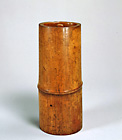Japanese Gallery (Honkan) Room 14
March 19, 2013 (Tue) - June 2, 2013 (Sun)
As the seasons change in Japan, people sometimes pray to deities or ancestors. Or, perhaps they perform the tea ceremony for an important guest. At such times, flowers are an essential part of the occasion.
In ancient times, flowers were used in Buddhism as important decorations at temples. The implements associated with flowers include ritual objects preserved at ancient temples, as well as treasures in the Shosoin Repository, Nara. The specific uses of these objects can also be seen in Buddhist paintings.
The activity of "arranging flowers" in its modern form can be recognized from as early as the Muromachi period (1392-1573), when the traditional style of Japanese house was developed. In traditional rooms, the tokonoma alcove featured a hanging scroll, as well as decorative flowers. The tokonoma played an important role as a space to help warrior-class people develop learning and spiritual nature. At this time in Japan, the ruling Ashikaga shogunate and others actively sought decorative art objects from China. In this period they also obtained many elegant vases made of metal or celadon ware.
From the end of the Muromachi period to the Azuchi-Momoyama period (1573-1603), vases made in Japan appeared in response to trends in the tea ceremony. In the wabi-cha style of tea ceremony, which stresses naturalness, incompleteness and simplicity, earthenware vases such as Bizen and Tanba ware, as well as original vases made from bamboo, gourds, and baskets, were highly prized. In addition to formal Chinese vases and unusual yet attractive Japanese vases, this exhibition also features vases in kosometsuke porcelain and Chinese overglaze enamels, both of which are ceramics well-known in Japan. We hope visitors enjoy the flower vases on display, with forms that have changed with the times.

